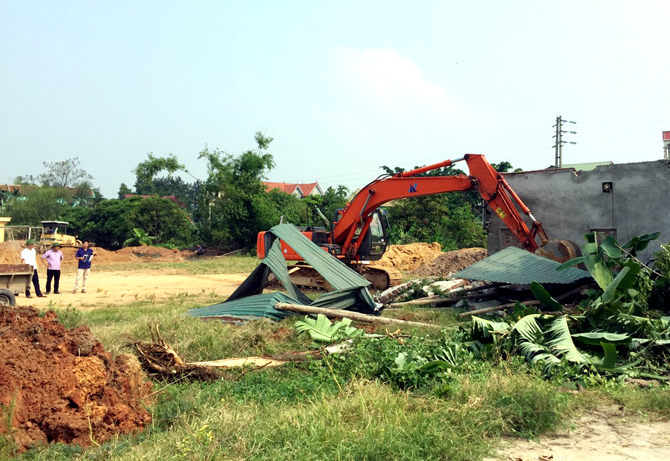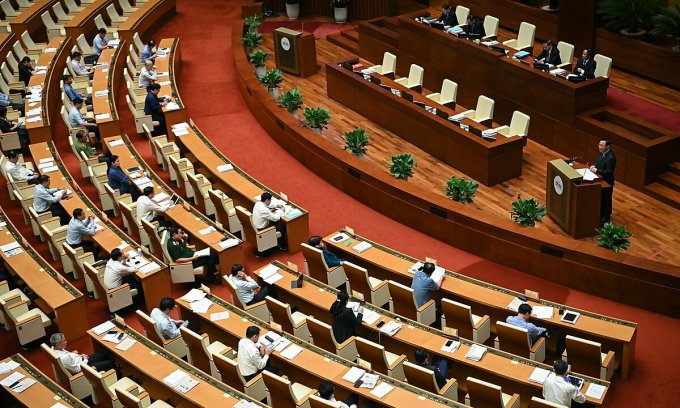Where to file a land dispute in Vietnam?

Land is one of the most sensitive and valuable resources. In the law, land is divided into immovable property, and is a very controversial issue. So about the matter “Where to file a land dispute in Vietnam?” Let’s find out with LSX in the article below.
Legal grounds
- Land Law 2013
- Civil Code 2015
What is a land dispute?
According to Clause 24, Article 3 of the 2013 Land Law, a land dispute is a dispute over the rights and obligations of land users between two or more parties in a land relationship.
Land dispute is the most common and complicated form of dispute today because it directly infringes upon the rights and obligations of land users.
Types of land disputes
Disputes over land use rights
– Disputes between users about boundaries between lands, this can be a dispute about adjacent land boundaries, lanes, etc. This type of dispute is usually caused by one party arbitrarily changing the boundary or The two parties cannot determine the boundary with each other, in some cases occupying the land area of other people.
+ Disputes for reclaiming land: this is a type of dispute for reclaiming land, reclaiming properties attached to land that were previously owned by them or their relatives, but due to various reasons they no longer exist manage and use. Now these people reclaim the person who is managing and using it, leading to a dispute.
This is a dispute arising in the process of land use unrelated to land transactions and land use right inheritance disputes. In essence, when settling this dispute, the court must determine who has the right to use the land. In this dispute, the statute of limitations does not apply.
Disputes over rights and obligations arising in the course of land use
These disputes can be requests for performance of contractual obligations, recognition of the validity of contracts, declaration of invalid civil transactions, etc.
Besides, another type of dispute of this type is a dispute about land use purposes: this is a type of dispute related to the determination of what is the purpose of land use; especially disputes over agricultural land and forestry land, between agricultural land and residential land in the process of allocation and use planning.
Disputes related to land
Includes two types of inheritance disputes related to land and property disputes when spouses divorce:
– Dispute over land use rights when husband and wife divorce: In case of dispute over land or property attached to land use right when husband and wife divorce. Disputes can be between husband and wife, or between a divorcee and a husband or wife’s household, or it can happen when parents give their children land, when the children divorce, parents claim back…
– Disputes over the right to inherit land use rights and assets attached to land use rights: This is a type of dispute in which the person with the land use right or property on land dies without leaving a will or leaving a will. The will is not in accordance with the provisions of law and the heirs cannot reach agreement on the division of inheritance or lack of understanding of the law, leading to a dispute.
How to define boundaries between properties?
Pursuant to Article 175 of the 2015 Civil Code, there are provisions on the determination of boundaries between real estate as follows:
“Article 175. Boundaries between real estates
1. The boundary between adjacent real estates shall be determined by agreement or by decision of a competent state agency.
Boundaries may also be determined by custom or by boundaries that have existed for 30 years or more without dispute.
Do not encroach on, occupy or change the boundary markers, even if the boundaries are canals, ditches, trenches, trenches or fields. All subjects have the obligation to respect and maintain common boundaries.
2. Land users may use space and the ground vertically from the boundary of the land plot in accordance with the provisions of law and must not affect the use of other people’s land.
Land users are only allowed to plant trees and do other things within the land area under their use rights and according to defined boundaries; if the tree roots or branches exceed the boundary, they must trim the roots, cut or prune the excess, unless otherwise agreed.”
In addition, according to Clause 11, Article 12 of the Law on Construction 2014, there are also prohibited acts as follows:
“Article 12. Prohibited acts
11. Using the works not in accordance with the purposes and functions of use; building expansion, encroaching on area, encroaching on space under lawful management and use of other organizations and individuals, public areas and common use areas.”
Where to file a land dispute in Vietnam?
When two parties have a dispute with each other over land that has been reached many times without success, they can write an application to the UNBD of communes or wards to intervene to resolve. Pursuant to Article 202, Land Law 2013.
Article 202. Land dispute conciliation
1. The State encourages the parties to a land dispute to conciliate themselves or settle the land dispute through grassroots conciliation.
2. For land disputes that the disputing parties cannot conciliate, they shall send an application to the commune-level People’s Committee of the locality where the disputed land is located for conciliation.
3. Commune-level People’s Committee presidents shall have to organize the conciliation of land disputes in their respective localities; in the course of implementation, must coordinate with the commune-level Vietnam Fatherland Front Committees, member organizations of the Front and other social organizations. Procedures for conciliation of land disputes at commune-level People’s Committees shall be carried out within 45 days from the date of receipt of a written request for settlement of land disputes.
4. The conciliation must be recorded in writing, signed by the parties and certified by the People’s Committee of the commune of the commune. The minutes of conciliation shall be sent to the disputing parties and kept at the commune-level People’s Committee of the locality where the disputed land is located.
5. In case of successful conciliation but there is a change in the status quo of boundaries and land users, the commune-level People’s Committees shall send the minutes of conciliation to the Division of Natural Resources and Environment in the case of land disputes. between households, individuals and communities; sent to the Department of Natural Resources and Environment for other cases.
The Division of Natural Resources and Environment, the Department of Natural Resources and Environment, shall submit to the People’s Committee of the same level a decision on recognition of the change of land plot boundaries and granting a new certificate of land use rights and ownership of houses and properties. other attached to the land.
If the mediation by the People’s Committee of the commune or ward is unsuccessful, either party may file a petition with the People’s Court of the district where the land is located. Specifically, the settlement of land disputes is regulated in Article 203, Land Law 2013 (Decree 43/2014/ND-CP).
Article 203. Competence to settle land disputes
Land disputes that have been unsuccessfully conciliated at the commune-level People’s Committees shall be settled as follows:
1. Land disputes in which the involved parties have certificates or one of the papers specified in Article 100 of this Law and disputes over property on land shall be settled by the People’s Courts;
2. In a land dispute where the involved party does not have a Certificate or one of the papers specified in Article 100 of this Law, the involved party may only choose one of two forms of land dispute settlement according to the provisions of this Law. the following provisions:
3. Commune-level People’s Committee presidents shall have to organize the conciliation of land disputes in their respective localities; in the course of implementation, must coordinate with the commune-level Vietnam Fatherland Front Committees, member organizations of the Front and other social organizations. Procedures for conciliation of land disputes at commune-level People’s Committees shall be carried out within 45 days from the date of receipt of a written request for settlement of land disputes.
4. The conciliation must be recorded in writing, signed by the parties and certified by the People’s Committee of the commune of the commune. The minutes of conciliation shall be sent to the disputing parties and kept at the commune-level People’s Committee of the locality where the disputed land is located.
5. In case of successful conciliation but there is a change in the status quo of boundaries and land users, the commune-level People’s Committees shall send the minutes of conciliation to the Division of Natural Resources and Environment in the case of land disputes. between households, individuals and communities; sent to the Department of Natural Resources and Environment for other cases.
The Division of Natural Resources and Environment, the Department of Natural Resources and Environment, shall submit to the People’s Committee of the same level a decision on recognition of the change of land plot boundaries and granting a new certificate of land use rights and ownership of houses and properties. other attached to the land.
If the mediation by the People’s Committee of the commune or ward is unsuccessful, either party may file a petition with the People’s Court of the district where the land is located. Specifically, the settlement of land disputes is regulated in Article 203, Land Law 2013 (Decree 43/2014/ND-CP).
Article 203. Competence to settle land disputes
Land disputes that have been unsuccessfully conciliated at the commune-level People’s Committees shall be settled as follows:
1. Land disputes in which the involved parties have certificates or one of the papers specified in Article 100 of this Law and disputes over property on land shall be settled by the People’s Courts;
2. In a land dispute where the involved party does not have a Certificate or one of the papers specified in Article 100 of this Law, the involved party may only choose one of two forms of land dispute settlement according to the provisions of this Law the following provisions:
a) File a request for dispute settlement at a competent People’s Committee as prescribed in Clause 3 of this Article;
b) File a lawsuit at a competent People’s Court in accordance with the law on civil procedures;
3. In case the involved parties choose to settle their dispute at the People’s Committee of a competent level, the land dispute shall be settled as follows:
a) In case of a dispute between households, individuals and communities, the chairperson of the district-level People’s Committee shall settle it; if they disagree with the settlement decision, they have the right to complain to the President of the provincial People’s Committee or initiate a lawsuit at the People’s Court in accordance with the law on administrative procedures;
b) In case of a dispute in which one of the disputing parties is an organization, religious establishment, overseas Vietnamese or foreign-invested enterprise, the President of the provincial People’s Committee shall settle it; if they disagree with the settlement decision, they have the right to complain to the Minister of Natural Resources and Environment or initiate a lawsuit at the People’s Court in accordance with the law on administrative procedures;
4. The person competent to settle land disputes specified in Clause 3 of this Article must issue a dispute settlement decision. An enforceable dispute settlement decision must be strictly observed by the disputing parties. In case the parties fail to comply, the enforcement will be enforced.
Thus, the settlement of land disputes falls under the jurisdiction of the Court or the competent People’s Committee.
The People’s Committees of communes and wards only have the authority to mediate between the two parties and this procedure is only encouraged but not required by law. For a land dispute case, you have the right to initiate a lawsuit directly to the Court.
Services of LSX
Prestigious professional services: Firstly, the team of consultants and consultants for many years in the field of civil status, and customer support.
On-time: Certainly, with the motto “Get your lawyer right at your fingertips”, we ensure the service always performs on time. The rights and interests of customers always come first.
Cost: Besides, LSX’s service costs are highly competitive; depending on the nature of the particular case. So, we want our guests to have the best possible service experience. Therefore, costs which guaranteed to be the most suitable and economical for customers.
Confidentiality of client information: Finally, all brand information of client LSX will be 100% confidential.
Please contact us immediately if you have any questions about “Where to file a land dispute in Vietnam?”
Contact LSX
Finally, hope this article is useful for you to answer the question about “Where to file a land dispute in Vietnam?” If you need any further information, please contact LSX Law firm: at +84846175333 or Email: [email protected]
Please see more
- Law on administrative proceedings for land disputes in Vietnam
- Vietnamese administrative procedure applicable to land disputes
- Agricultural land use regime according to Vietnam land law
Frequently asked questions
According to regulations, only when the conciliation at the Commune People’s Committee ends without successful conciliation, the application for settlement can be filed at the Court.
According to Clause 3, Article 202 of the Land Law 2013, the procedures for land dispute conciliation at the commune-level People’s Committees shall be carried out within no more than 45 days from the date of receipt of the request for land dispute settlement.
– Complaint according to the form;
Personal papers of the petitioner (copy of citizen identification, copy of people’s identity card, copy of passport);
Papers proving the residence of the plaintiff and the defendant (if any);
Minutes of unsuccessful conciliation certified by the Commune People’s Committee and signed by the disputing parties.
– Papers of the petitioner: Household book, people’s identity card or citizen identification card or valid passport.
A list of documents and evidences enclosed with the petition.
Conclusion: So the above is Where to file a land dispute in Vietnam?. Hopefully with this article can help you in life, please always follow and read our good articles on the website: lsxlawfirm.com




